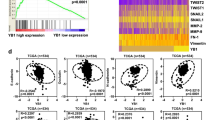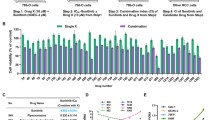Abstract
Multi-target tyrosine kinase inhibitor Sunitinib has been widely used in cancer treatment, including metastatic renal cell carcinoma. However, most patients who initially benefit from Sunitinib develop resistance with extended usage of Sunitinib, which is referred to as “acquired resistance”. The molecular mechanisms contributing to this acquired resistance remain poorly understood. In this present study, we established Sunitinib-resistant cell lines from human renal cell lines (786-O, A498, ACHN and CAKI1) by continuous treatment with Sunitinib to explore the molecular mechanism leading to Sunitinib resistance. We found that PDGFR-β expression in cell seems to be a protective factor against Sunitinib resistance formation. In addition, we found that both SK1 and ERK were activated in Sunitinib-resistance cell lines and SK1 and ERK inhibitors could resensitize Sunitinib-resistant cell lines. In conclusion, our observations suggest that SK1 and ERK activation is a feature of resistant cell lines, which serves as an alternative pathway evading anti-tumor activity of Sunitinib.



Similar content being viewed by others
References
Antonelli, A., et al. (2007). The follow-up management of non-metastatic renal cell carcinoma: Definition of a surveillance protocol. BJU International, 99(2), 296–300.
Itsumi, M., & Tatsugami, K. (2010). Immunotherapy for renal cell carcinoma. Clinical and Developmental Immunology, 2010, 284581.
Faivre, S., et al. (2007). Molecular basis for sunitinib efficacy and future clinical development. Nature Reviews. Drug Discovery, 6(9), 734–745.
Irani, J. (2007). Sunitinib versus interferon-alpha in metastatic renal-cell carcinoma. Progres en Urologie, 17(5), 996.
Motzer, R. J., et al. (2007). Sunitinib efficacy against advanced renal cell carcinoma. Journal of Urology, 178(5), 1883–1887.
Huang, D., et al. (2010). Interleukin-8 mediates resistance to antiangiogenic agent sunitinib in renal cell carcinoma. Cancer Research, 70(3), 1063–1071.
Farber, E., & Rubin, H. (1991). Cellular adaptation in the origin and development of cancer. Cancer Research, 51(11), 2751–2761.
Song, L., et al. (2011). Sphingosine kinase-1 enhances resistance to apoptosis through activation of PI3 K/Akt/NF-kappaB pathway in human non-small cell lung cancer. Clinical Cancer Research, 17(7), 1839–1849.
Marfe, G., et al. (2011). Sphingosine kinase 1 overexpression is regulated by signaling through PI3K, AKT2, and mTOR in imatinib-resistant chronic myeloid leukemia cells. Experimental Hematology, 39(6), 653–665.
Rupal S, B., et al. Sphingosine-1-phosphate (S1P) as a novel target in renal cancer (RCC). in AACR 101st Annual Meeting 2010. 2011. Washington, DC: Cancer Research.
Kuroda, K., et al. (2009). Activated Akt prevents antitumor activity of gefitinib in renal cancer cells. Urology, 74(1), 209–215.
Martinelli, E., et al. (2010). Synergistic antitumor activity of sorafenib in combination with epidermal growth factor receptor inhibitors in colorectal and lung cancer cells. Clinical Cancer Research, 16(20), 4990–5001.
Morgillo, F., et al. (2011). Antitumor activity of sorafenib in human cancer cell lines with acquired resistance to EGFR and VEGFR tyrosine kinase inhibitors. PLoS One, 6(12), e28841.
Cho, S. Y., et al. (2011). Sphingosine kinase 1 pathway is involved in melatonin-induced HIF-1alpha inactivation in hypoxic PC-3 prostate cancer cells. Journal of Pineal Research, 51(1), 87–93.
Abrams, T. J., et al. (2003). SU11248 inhibits KIT and platelet-derived growth factor receptor beta in preclinical models of human small cell lung cancer. Molecular Cancer Therapeutics, 2(5), 471–478.
Chow, L. Q., & Eckhardt, S. G. (2007). Sunitinib: from rational design to clinical efficacy. Journal of Clinical Oncology, 25(7), 884–896.
Rubinson, D. A., et al. (2003). A lentivirus-based system to functionally silence genes in primary mammalian cells, stem cells and transgenic mice by RNA interference. Nature Genetics, 33(3), 401–406.
Li, H., et al. (2011). Blocking the PI3K/AKT and MEK/ERK signaling pathways can overcome gefitinib-resistance in non-small cell lung cancer cell lines. Advances in Medical Sciences, 56(2), 275–284.
Pchejetski, D., et al. (2011). Therapeutic potential of targeting sphingosine kinase 1 in prostate cancer. Nature Reviews Urology, 8(10), 569–678.
Huang, D., et al. (2010). Sunitinib acts primarily on tumor endothelium rather than tumor cells to inhibit the growth of renal cell carcinoma. Cancer Research, 70(3), 1053–1062.
Olson, P., et al. (2011). Imaging guided trials of the angiogenesis inhibitor sunitinib in mouse models predict efficacy in pancreatic neuroendocrine but not ductal carcinoma. Proceedings of the National Academy of Sciences of the United States of America, 108(49), E1275–E1284.
Powles, T., et al. (2011). Sunitinib and other targeted therapies for renal cell carcinoma. British Journal of Cancer, 104(5), 741–745.
Mendel, D. B., et al. (2003). In vivo antitumor activity of SU11248, a novel tyrosine kinase inhibitor targeting vascular endothelial growth factor and platelet-derived growth factor receptors: Determination of a pharmacokinetic/pharmacodynamic relationship. Clinical Cancer Research, 9(1), 327–337.
Schueneman, A. J., et al. (2003). SU11248 maintenance therapy prevents tumor regrowth after fractionated irradiation of murine tumor models. Cancer Research, 63(14), 4009–4016.
Tanaka, Y., et al. (2011). Sunitinib suppresses tumor growth and metastases in a highly metastatic mouse mammary cancer model. Anticancer Research, 31(4), 1225–1234.
Seandel, M., et al. (2006). The activity of sunitinib against gastrointestinal stromal tumor seems to be distinct from its antiangiogenic effects. Clinical Cancer Research, 12(20 Pt 1), 6203–6204.
de Bouard, S., et al. (2007). Antiangiogenic and anti-invasive effects of sunitinib on experimental human glioblastoma. Neuro-Oncology, 9(4), 412–423.
Xin, H., et al. (2009). Sunitinib inhibition of Stat3 induces renal cell carcinoma tumor cell apoptosis and reduces immunosuppressive cells. Cancer Research, 69(6), 2506–2513.
Oliner, J., et al. (2004). Suppression of angiogenesis and tumor growth by selective inhibition of angiopoietin-2. Cancer Cell, 6(5), 507–516.
Cenni, E. (2005). Inhibition of angiogenic activity of renal carcinoma by an antisense oligonucleotide targeting fibroblast growth factor-2. Anticancer Research, 25(2A), 1109–1113.
Bergers, G., & Hanahan, D. (2008). Modes of resistance to anti-angiogenic therapy. Nature Reviews Cancer, 8(8), 592–603.
Cuvillier, O., et al. (2010). Activation of sphingosine kinase-1 in cancer: implications for therapeutic targeting. Current Molecular Pharmacology, 3(2), 53–65.
Pyne, N. J., & Pyne, S. (2010). Sphingosine 1-phosphate and cancer. Nature Reviews Cancer, 10(7), 489–503.
Hu, S., et al. (2009). Interaction of the multikinase inhibitors sorafenib and sunitinib with solute carriers and ATP-binding cassette transporters. Clinical Cancer Research, 15(19), 6062–6069.
Shukla, S., et al. (2009). Sunitinib (Sutent, SU11248), a small-molecule receptor tyrosine kinase inhibitor, blocks function of the ATP-binding cassette (ABC) transporters P-glycoprotein (ABCB1) and ABCG2. Drug Metabolism and Disposition, 37(2), 359–365.
Acknowledgments
This work was supported by the Funds of Chongqing Normal University (No. 12XLB025).
Author information
Authors and Affiliations
Corresponding author
Rights and permissions
About this article
Cite this article
Gao, H., Deng, L. Sphingosine Kinase-1 Activation Causes Acquired Resistance Against Sunitinib in Renal Cell Carcinoma Cells. Cell Biochem Biophys 68, 419–425 (2014). https://doi.org/10.1007/s12013-013-9723-4
Published:
Issue Date:
DOI: https://doi.org/10.1007/s12013-013-9723-4




